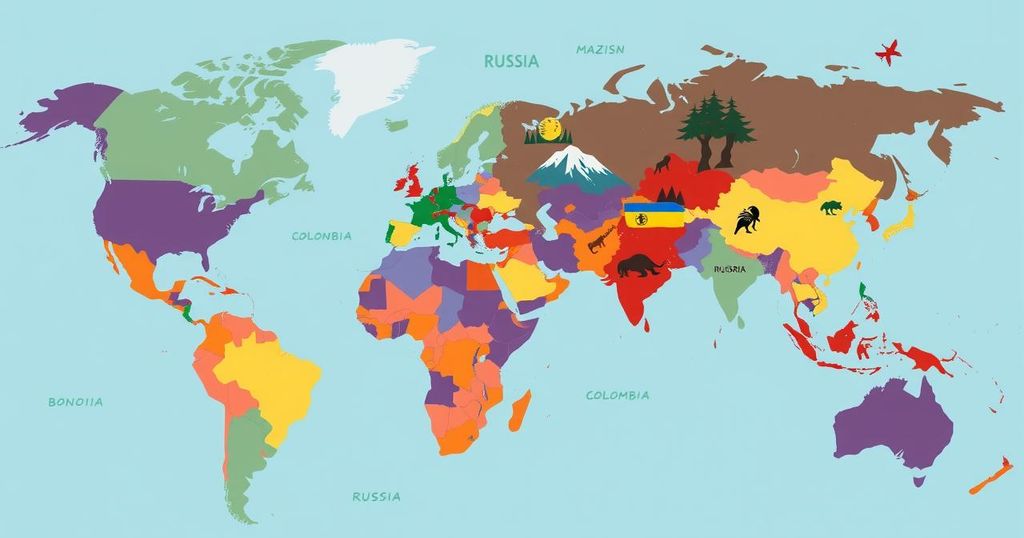The U.S. Department of State has issued Level 4 travel advisories—”Do Not Travel”—for various countries including Afghanistan, Venezuela, and the Democratic Republic of the Congo due to concerns over crime and political instability. These advisories affect popular tourist destinations, urging American citizens to reconsider travel plans amid rising security risks.
In a recent update, the U.S. Department of State has announced elevated travel advisories for numerous popular spring break locations throughout Latin America and the Caribbean, including countries such as Russia, Jamaica, Colombia, Belarus, Yemen, Syria, and several others. These advisories range from Level 3 (Reconsider Travel) to Level 4 (Do Not Travel) and have been instigated by escalating concerns regarding crime, political instability, and gang violence in these regions. As spring break approaches, the perception of these tourist destinations among American travelers has notably shifted.
Despite traditionally attracting millions of American tourists due to their cultural appeal and scenic landscapes, the recent travel warnings indicate an emerging security crisis that jeopardizes the safety of both residents and visitors. The advisories stem from a rise in violent incidents, which encompass armed robberies, kidnappings, and civil unrest within key tourist areas. Consequently, the U.S. government has issued pressing safety recommendations for American citizens.
The U.S. Department of State categorizes travel risks into four advisory levels, with a Level 4 advisory denoting the most severe warning of “Do Not Travel.” Such advisories are issued when safety and security risks in a destination are considered excessively high due to factors like civil unrest or ongoing conflict.
The warnings issued reflect a pertinent trend, as more nations are being classified under Level 4 advisories. Travelers are being urged to rethink their travel plans to regions experiencing serious conflicts and deteriorating security situations. Countries presently under a Level 4 advisory include Afghanistan, the Democratic Republic of the Congo, Lebanon, the Central African Republic, Belarus, Iraq, Ukraine, Venezuela, and Haiti, among others.
The situation in Afghanistan remains perilous for travelers, primarily due to ongoing conflict and an increased risk of kidnapping by extremist groups. Additionally, the healthcare system is severely lacking, further endangering the safety of any potential visitors. The U.S. advisory to refrain from travel to Afghanistan remains stringent.
The Democratic Republic of the Congo also poses significant dangers, plagued by decades of conflict and violence perpetrated by armed militias. Travelers are advised against visiting, as the country faces continuous civil unrest and health crises, including the threat of Ebola.
Lebanon faces severe political instability and economic distress, aggravated by ongoing protests and the threat of terrorism, particularly in regions near the Syrian border. The U.S. government advises against all travel to Lebanon in light of these compounded risks.
In the Central African Republic, ongoing armed conflicts jeopardize the safety of travelers, with U.S. citizens strongly discouraged from entering due to the high violence levels and insufficient law enforcement.
Political repression in Belarus has exasperated safety concerns, particularly following recent government crackdowns on dissent, further complicating travel for U.S. citizens. In Iraq, the threat of terrorist activities and armed conflict renders travel extremely dangerous, prompting the U.S. government to strongly discourage visits.
As a result of the ongoing war in Ukraine following the Russian invasion, American travelers are warned to avoid the country altogether due to the active combat zones and significant humanitarian crisis. Venezuela’s political and economic turmoil continues to pose security risks, leading the U.S. government to caution against travel to this nation.
Haiti remains unsafe for American tourists, with rampant gang violence and kidnappings forcing the U.S. Department of State to issue a Level 4 travel advisory.
The U.S. travel advisory system helps citizens recognize regions that present substantial safety risks, especially concerning crime rates, political instability, and emergency service accessibility. Unfortunately, despite these risks, many spring break travelers continue to visit these destinations, often uninformed about or disregarding the advisories.
Travelers intending to visit high-risk countries should prioritize their safety by staying informed, utilizing resources like the U.S. State Department’s travel advisory website, and enrolling in programs that help them stay connected with local embassies.
The increasing number of countries under Level 4 advisories significantly influences the travel industry as airlines, and tour operators may need to reassess their offerings based on these security concerns. Ultimately, the rise of such advisories reflects the necessity for travelers to exercise caution, particularly during the rapidly approaching spring break season.
As the spring break period draws near, American travelers should remain acutely aware of the heightened safety risks associated with several popular destinations currently under Level 4 travel advisories. These warnings emphasize the importance of informed travel decisions and stress the need for vigilance within the travel industry. As these advisories shape the travel landscape, it is essential for travelers to plan responsibly and prioritize their safety when considering trips to high-risk regions.
Original Source: www.travelandtourworld.com




